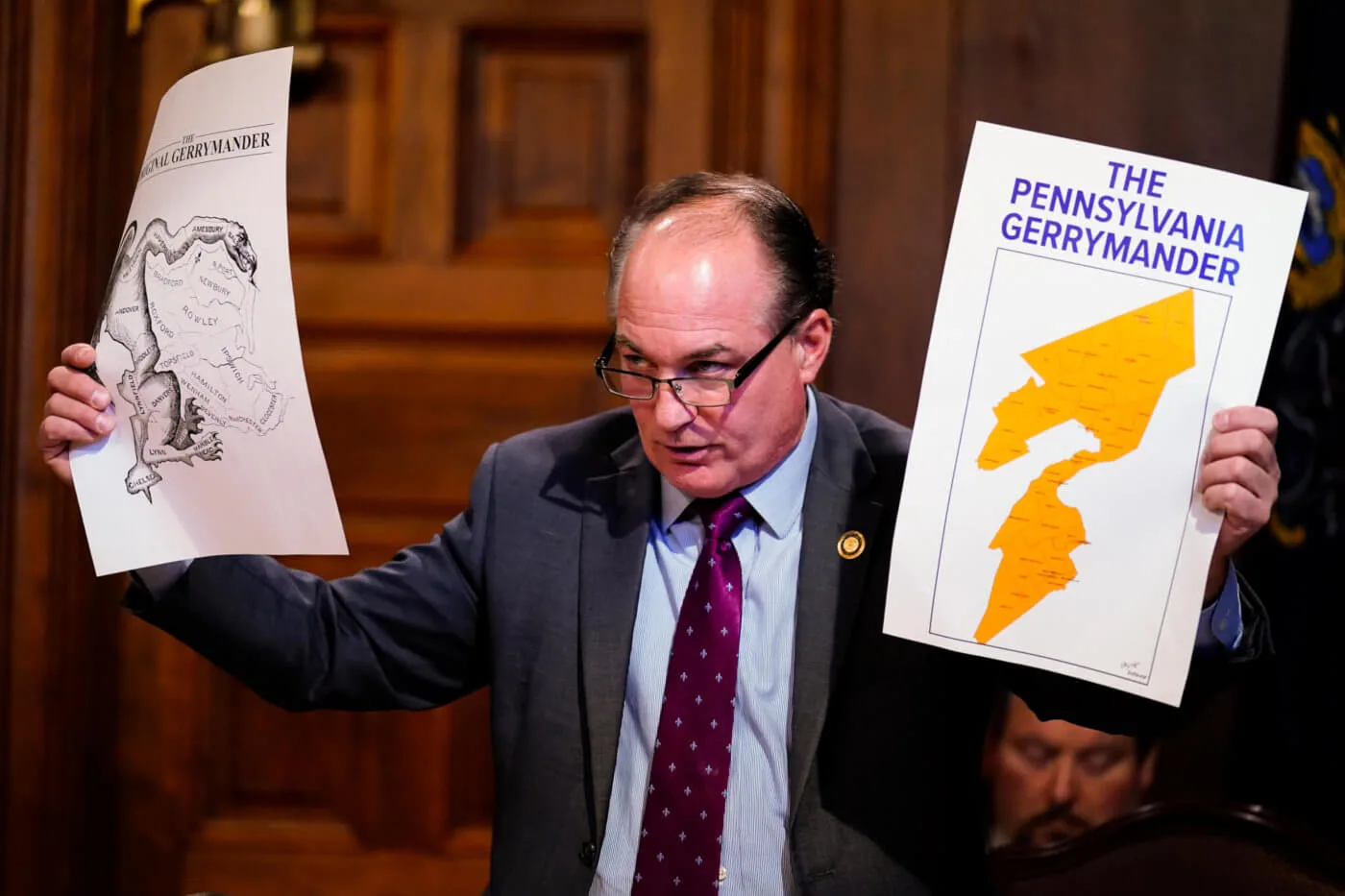
House Majority Leader Kerry Benninghoff, R-Centre holds up maps during a meeting of the Pennsylvania Legislative Reapportionment Commission at the Capitol in Harrisburg, Pa., Thursday, Dec. 16, 2021. The commission voted Thursday in favor of new preliminary district maps over sharp objections from the House's Republican leader about how his chamber's district lines would change. (AP Photo/Matt Rourke)
As expected, the courts will likely end up deciding how both Pennsylvania’s legislative and congressional districts will look for the next 10 years.
Even in the most congenial of political climates, the once-every-10-years process of setting new legislative and congressional districts in Pennsylvania is fraught with problems, like legislators trying to redraw those boundaries in the best interests of their party, not their constituents.
We took a look last month at the process behind drawing new legislative and congressional maps, and what’s at stake politically in this latest round of redistricting.
That process is still playing out and, as expected, the courts will likely end up deciding how both Pennsylvania’s legislative and congressional districts will look for the next 10 years. The impasse has not impacted Pennsylvania’s primary date (May 17) yet, but it has delayed the start of the three-week window for potential candidates to garner enough petition signatures to get on the primary ballot, which was to begin Feb. 15.
Here’s where things stand with the maps.
Legislative Map
The majority-Democratic Legislative Reapportionment Commission approved new maps for Pennsylvania’s House and Senate districts last Friday in a 4-1 vote. The new boundaries were drawn to reflect Pennsylvania’s rapidly-growing Latino population, which could impact the makeup of the predominantly white House and Senate.
House Majority Leader Kerry Benninghoff (R-Centre) cast the dissenting vote, accusing his Democratic colleagues of gerrymandering. The other Republican on the commission, Senate Majority Leader Kim Ward (Westmoreland), said the Senate map was “imperfect,” but still constitutional.
House Republicans are preparing to challenge the House map in the state Supreme Court. The deadline to bring any challenge is March 7. It likely would take several weeks to resolve any challenges.
Congressional Map
Republican and Democratic lawmakers, party supporters on both sides of the aisle, Gov. Tom Wolf, and good-government groups submitted proposals for more than a dozen redrawn maps to PA’s Commonwealth Court last month after Wolf and the Republican-controlled legislature deadlocked on how Pennsylvania’s 17 congressional districts (down from the current 18) should look.
On Monday, Commonwealth Court Judge Patricia McCullough, a Republican, recommended a map to the state Supreme Court that passed the Republican-controlled Legislature last month without support from a single Democratic lawmaker. Democrats claim the map would unfairly tilt Pennsylvania’s congressional delegation (currently split 9-9) in favor of Republicans.
The map’s fate now rests with the majority-Democratic Supreme Court. Hearings will begin Feb. 18.
Information from the Associated Press was used in this report.
Politics

Susan Wild calls out Republicans for holding up Ukraine aid
‘It’s not only shameful, but embarassing.” That’s what US Rep. Susan Wild (D-Pennsylvania) had to say about the Republican-led US House’s...

He said what? 10 things to know about RFK Jr.
The Kennedy family has long been considered “Democratic royalty.” But Robert F. Kennedy, Jr.—son of Robert F. Kennedy, who was assassinated while...

Shapiro says Pennsylvania will move all school standardized testing online in 2026
Pennsylvania Gov. Josh Shapiro said Thursday that his administration will move all standardized school assessment tests online in an effort to save...
Local News

Conjoined twins from Berks County die at age 62
Conjoined twins Lori and George Schappell, who pursued separate careers, interests and relationships during lives that defied medical expectations,...

Railroad agrees to $600 million settlement for fiery Ohio derailment, residents fear it’s not enough
Norfolk Southern has agreed to pay $600 million in a class-action lawsuit settlement for a fiery train derailment in February 2023 in eastern Ohio,...






